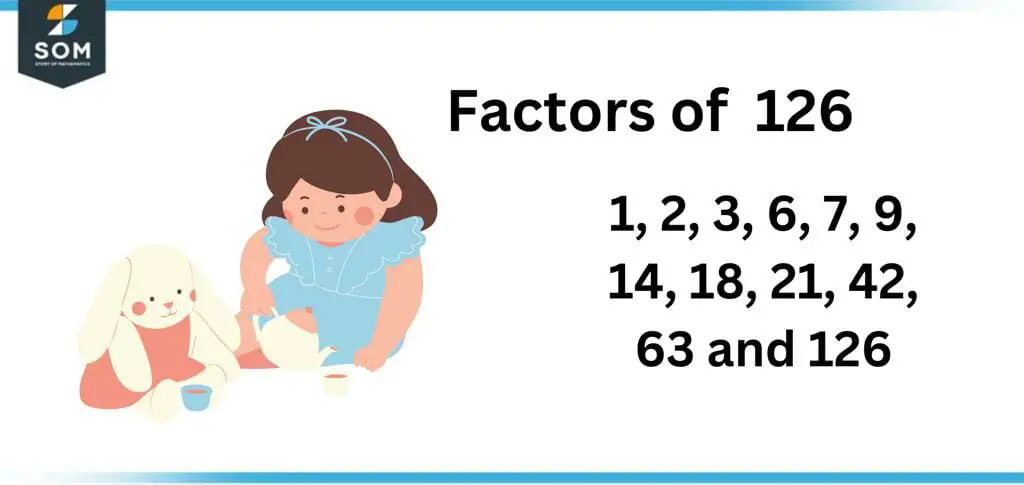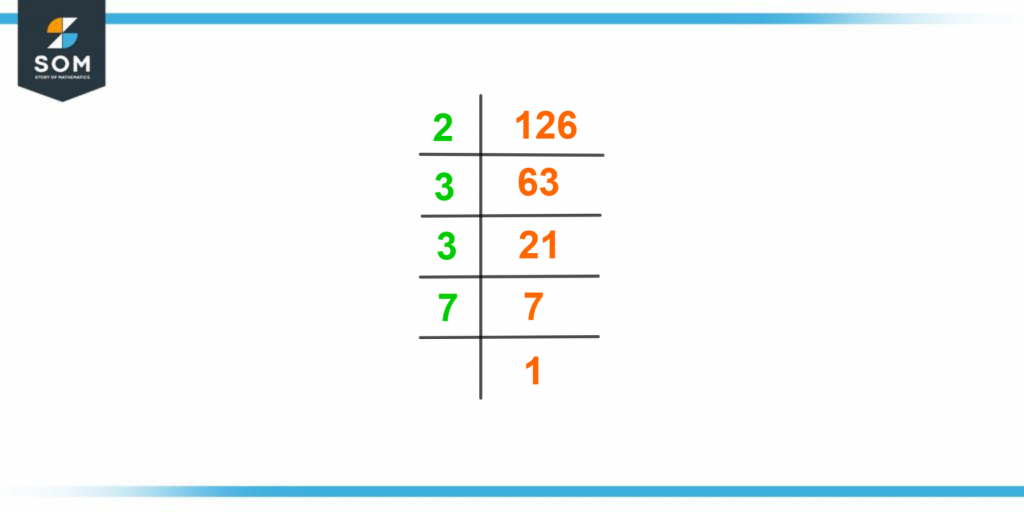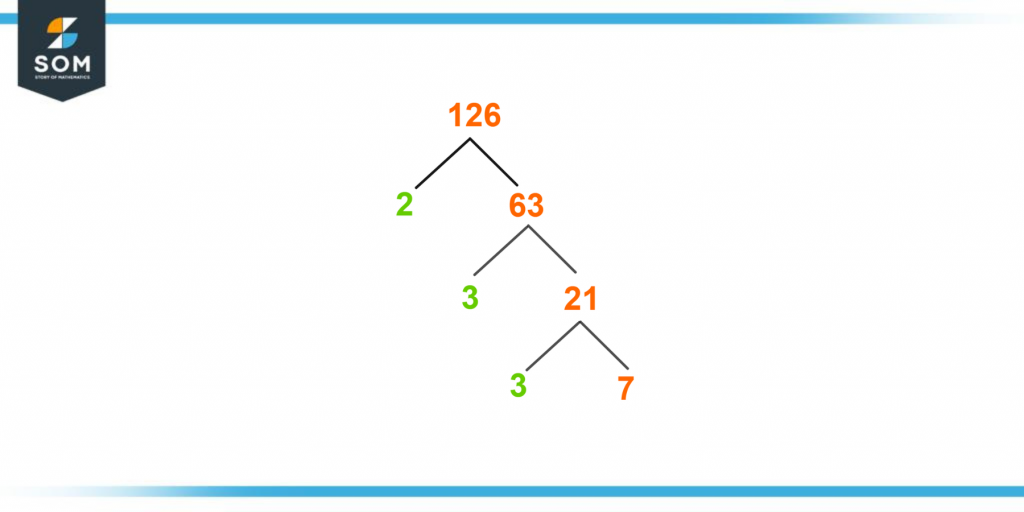JUMP TO TOPIC
Factors 0f 126: Prime Factorization, Methods, Tree, and Examples
The factors of 126 are the numbers that produce 126 when multiplied by each other in pairs. In other words, the factors of 126 can be stated as below:
Figure 1 – All possible Factors of 126
What Are the Factors of 126?
The factors of 126 are 1, 2, 3, 6, 7, 9, 14, 18, 21, 42, 63, and 126.126 is an even as well as a composite number. The total number of factors of 126 is 12. They perfectly divide 126 into equal parts without remainder. When 126 is divided by these three numbers, it is fully divided with zero remainders.How To Calculate the Factors of 126?
You can calculate the factors of 126 by determining the list of numbers that are wholly divisible by 126. The most commonly used method to find factors of 126 is factorization by the traditional division method.To find the factors of 126 by the division method, begin with dividing 126 by the smallest positive integral number that divides 126 entirely and proceed with consecutive positive critical numbers up to the number 126 reaches.Divide 126 by the smallest natural number, i.e., 1.\[\dfrac{126}{1} = 126 , r = 0 \]As it has completely divided 126 and the remainder is zero (i.e., r=0), 1 is a factor of 126.Now, divide 126 by the smallest even prime number, i.e., 2.\[\dfrac{126}{2} = 63, r = 0 \]As it has again divided 126 completely because a resulting quotient is a whole number, and the remainder is zero. Therefore 2 is a factor of 126.The number 126 can be entirely divided by 3 as the cross sum of 126 is nine, which is a divisor by 3 (divisibility rule of 3). Therefore, 3 can be included in the factor list of 126.\[\dfrac{126}{3} = 42 , r = 0 \]Now apply the Divisibility Rule of 6 to find out that 6 is a factor of 126. The number that can be wholly divided by 3 can also be divided by 6. As 126 is an even number, it is divisible by 3. Therefore it is also divided by 6.\[\dfrac{126}{6} = 21 , r = 0 \]Now divide 126 by the next natural number, which is 7.\[\dfrac{126}{7} = 18, r= 0 \]As 7 has divided 126 exactly, and the quotient is in fraction. So, 7, too, is a factor of 126.After 7, divide 126 by consecutive natural numbers to find factors of 126.\[\dfrac{126}{9} = 14, r = 0 \]\[\dfrac{126}{14} = 9, r = 0 \]\[\dfrac{126}{18} = 7, r = 0 \]\[\dfrac{126}{21} = 6, r = 0 \]\[\dfrac{126}{42} = 3, r = 0 \]\[\dfrac{126}{63} = 2, r = 0 \]\[\dfrac{126}{126} = 1, r = 0 \]The above division proves that 1, 2, 3, 6, 7, 9, 14, 18, 21, 42, 63, and 126) are factors of 126 because these numbers have divided 126 completely.Information About Factors of 126
- All divisors of a number 126 are also factors of 126 irrespective of prime or composite numbers.
- Factors of 126 can never be in fractions or decimals.
- Factors of 126 can be positive as well as negative.
Factors of 126 by Prime Factorization
When the number 126 is expressed in the form of multiplication of all its possible prime factors, it is known as the prime factorization of the number 126. This method is most commonly used to calculate the factors of a given number.To find factors of 126 by the prime factorization method, divide 126 by the smallest prime number, which divides 126 precisely without any remainder. Then the quotient is again divided by the smallest prime number, and the procedure continues until we get the quotient as 1.Following is the method to calculate factors of 126 by prime factorization.First, divide 126 by the smallest possible prime number divisor, 2.\[\dfrac{126}{2} = 63 \]Secondly, divide the quotient 63 by the smallest possible prime number divisor, which is 3.\[\dfrac{63}{3} = 21 \]Thirdly, divide the quotient 21 again by 3.\[\dfrac{21}{3} = 7 \]At last, the quotient 7 is a prime number and divisible by itself only.\[\dfrac{7}{7} = 1 \] Therefore, the prime factorization of 126 can be stated asPrime Factorization of 126 = 2 × 3 × 3 × 7
The prime factorization of 126 can also be depicted as\[126 = 2 \times 3^2 \times 7 \]The prime factorization of 126 is shown in following figure 1:
Figure 2 – Prime Factorization of 126
Factor Tree of 126
A factor tree is another way to find the factors of 126. It can be regarded as a graphical presentation of the prime factorization of a number. It also helps to segregate the number’s prime and composite factors. Factors of 126 are shown as a tree diagram in figure 2. The branches of the tree split to produce factors as a result.One of the factors into which branch splits is a prime number, whereas the other number that can be further divided is composite. It is advised to keep dividing the obtained composite numbers until the further division is impossible and the obtained numbers are prime factors. At this point, the branches terminate, and the process stops.According to the rules of factor tree methods, the number 126 can be written into its multiples; it is shown as:126 = 2 × 63
On dividing 63 into its multiples as follows:63 = 3 × 21
By splitting 21 into its multiples as shown below:21 = 3 × 7
One more thing notice worthy is that the number 21 has produced prime numbers at both branches. Further division is impossible. Therefore, the factor tree appears as:126 = 2 × 3 × 3 × 7
Factor Tree of 126 can be shown in the following figure 2.
Figure 3 – Factor Tree of 126
Factors of 126 in Pairs
The factors of 126 in pairs are the sets of two integral numbers whose product gives us the number 126 are called factors of 126 in pairs. In other terms, it is the product of the factors of the number 126 represented in the form of pairs.Pair Factors are a pair of numbers multiplied by each other, giving the result 126. Here are the pair factors of 126.1 × 126 = 126
2 × 63 = 126
3 × 42 = 126
6 × 21 = 126
7 × 18 = 126
9 × 14 = 126
Hence, the factors of 126 can be written in pairs as follows:(1, 126)
(2, 63)
(3, 42)
(6, 21)
(7, 18)
(9, 14)
126 can also have two negative numbers as pair factors. For instance:(-2) × (-63) = 126
(-3) × (-42) = 126
(-6) × (-21) = 126
The negative factor pairs of 126 can be depicted as follows:(-1, -126)
(-2, -63)
(-3, -42)
(-6, -21)
(-7, -18)
(-9, -14)
It can be stated that the product of all factors of 126 in its additive inverse form gives the result 126. Thus, these are termed negative factors.Important Facts About 126
- 126 is an even and composite number.
- 126 has only three prime factors.
- 126 has 12 divisors.
Factors of 126 Solved Examples
Example 1
Express 126 in the form of its prime factorization.Solution
As we know:Prime Factorization of 126 = 2 × 3 × 3 × 7
The prime factorization of 126 can also be depicted as:126 = 2 x 3$^2$ x 7
Example 2
Julia has been assigned a task to find the average of factors of 126. How will she find the described average?Solution
Julia is aware that the factors of 126 are 1, 2, 3, 6, 7, 9, 14, 18, 21, 42, 63, and 126.She also knows that:Average of factors of 126 = Sum of factors of 126 ÷ Count of factors of 126.
Sum of factors of 126 = 1 + 2 + 3 + 6 + 7 + 9 + 14 + 18 + 21 + 42 + 63 + 126
Sum of divisors of 126 = 312
Count of factors of 126 = 12
Average of factors of 126 = 312 ÷ 12
Average of factors of 126 = 26
Images/mathematical drawings are created with GeoGebra.